2010 CHEVROLET CORVETTE child restraint
[x] Cancel search: child restraintPage 67 of 472
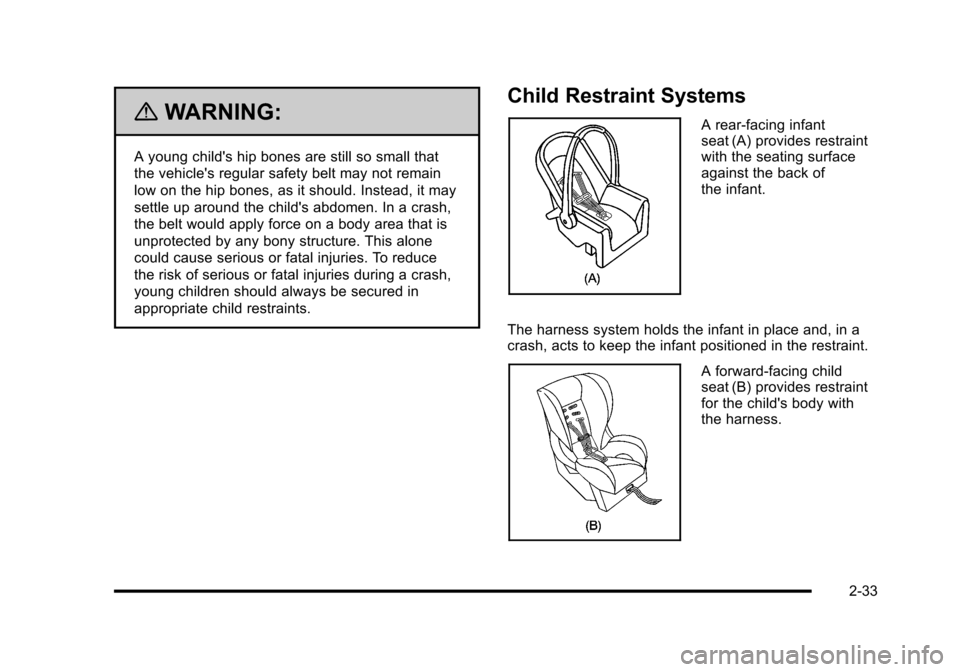
{WARNING:
A young child's hip bones are still so small that
the vehicle's regular safety belt may not remain
low on the hip bones, as it should. Instead, it may
settle up around the child's abdomen. In a crash,
the belt would apply force on a body area that is
unprotected by any bony structure. This alone
could cause serious or fatal injuries. To reduce
the risk of serious or fatal injuries during a crash,
young children should always be secured in
appropriate child restraints.
Child Restraint Systems
A rear-facing infant
seat (A) provides restraint
with the seating surface
against the back of
the infant.
The harness system holds the infant in place and, in a
crash, acts to keep the infant positioned in the restraint.
A forward-facing child
seat (B) provides restraint
for the child's body with
the harness.
2-33
Page 68 of 472
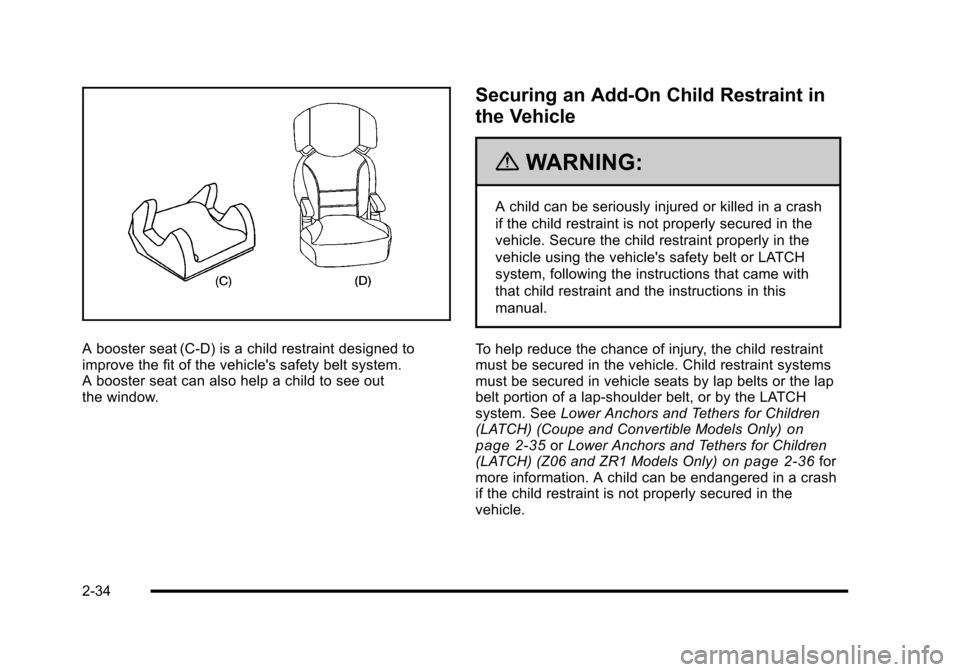
A booster seat (C-D) is a child restraint designed to
improve the fit of the vehicle's safety belt system.
A booster seat can also help a child to see out
the window.
Securing an Add-On Child Restraint in
the Vehicle
{WARNING:
A child can be seriously injured or killed in a crash
if the child restraint is not properly secured in the
vehicle. Secure the child restraint properly in the
vehicle using the vehicle's safety belt or LATCH
system, following the instructions that came with
that child restraint and the instructions in this
manual.
To help reduce the chance of injury, the child restraint
must be secured in the vehicle. Child restraint systems
must be secured in vehicle seats by lap belts or the lap
belt portion of a lap-shoulder belt, or by the LATCH
system. See Lower Anchors and Tethers for Children
(LATCH) (Coupe and Convertible Models Only)
on
page 2‑35or Lower Anchors and Tethers for Children
(LATCH) (Z06 and ZR1 Models Only)on page 2‑36for
more information. A child can be endangered in a crash
if the child restraint is not properly secured in the
vehicle.
2-34
Page 69 of 472

When securing an add-on child restraint, refer to the
instructions that come with the restraint which may be
on the restraint itself or in a booklet, or both, and to this
manual. The child restraint instructions are important,
so if they are not available, obtain a replacement copy
from the manufacturer.
Keep in mind that an unsecured child restraint can
move around in a collision or sudden stop and injure
people in the vehicle. Be sure to properly secure any
child restraint in the vehicle —even when no child is
in it.
Securing the Child Within the Child
Restraint
{WARNING:
A child can be seriously injured or killed in a crash
if the child is not properly secured in the child
restraint. Secure the child properly following the
instructions that came with that child restraint.
Lower Anchors and Tethers for
Children (LATCH) (Coupe and
Convertible Models Only)
Some child restraints have a LATCH system. As part of
the LATCH system, your child restraint may have lower
attachments and/or a top tether. The LATCH system
can help hold the child restraint in place during driving
or in a crash. Some vehicles have lower and/or top
tether anchors designed to secure a child restraint with
lower attachments and/or a top tether.
Some child restraints with a top tether are designed
to be used whether the top tether is anchored or not.
Other child restraints require that the top tether be
anchored. A national or local law may require that
the top tether be anchored.
In Canada, the law requires that forward-facing child
restraints have a top tether, and that the tether be
attached.
2-35
Page 70 of 472
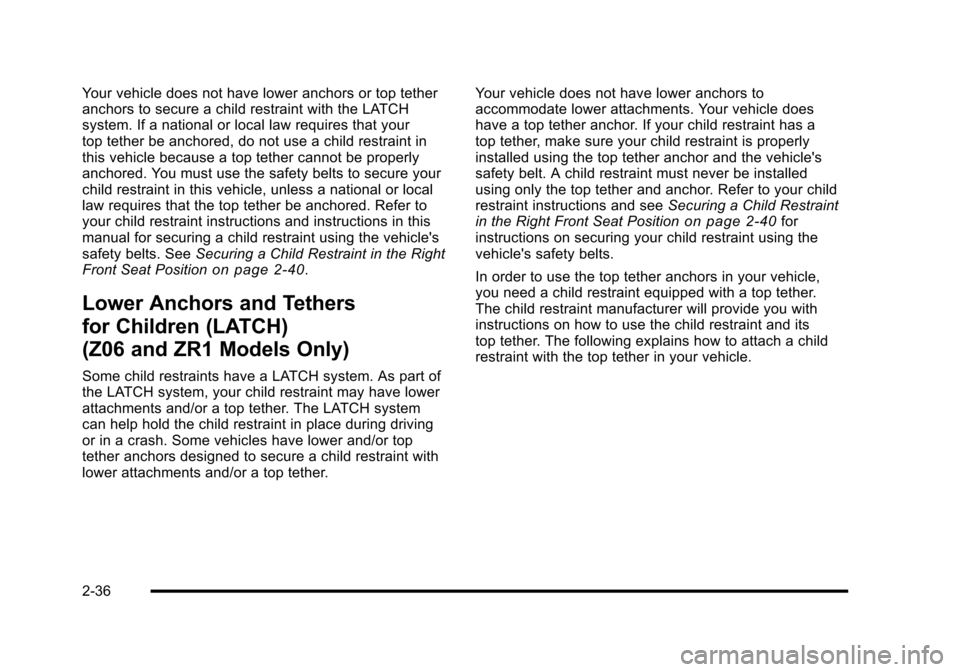
Your vehicle does not have lower anchors or top tether
anchors to secure a child restraint with the LATCH
system. If a national or local law requires that your
top tether be anchored, do not use a child restraint in
this vehicle because a top tether cannot be properly
anchored. You must use the safety belts to secure your
child restraint in this vehicle, unless a national or local
law requires that the top tether be anchored. Refer to
your child restraint instructions and instructions in this
manual for securing a child restraint using the vehicle's
safety belts. See Securing a Child Restraint in the Right
Front Seat Position
on page 2‑40.
Lower Anchors and Tethers
for Children (LATCH)
(Z06 and ZR1 Models Only)
Some child restraints have a LATCH system. As part of
the LATCH system, your child restraint may have lower
attachments and/or a top tether. The LATCH system
can help hold the child restraint in place during driving
or in a crash. Some vehicles have lower and/or top
tether anchors designed to secure a child restraint with
lower attachments and/or a top tether. Your vehicle does not have lower anchors to
accommodate lower attachments. Your vehicle does
have a top tether anchor. If your child restraint has a
top tether, make sure your child restraint is properly
installed using the top tether anchor and the vehicle's
safety belt. A child restraint must never be installed
using only the top tether and anchor. Refer to your child
restraint instructions and see
Securing a Child Restraint
in the Right Front Seat Position
on page 2‑40for
instructions on securing your child restraint using the
vehicle's safety belts.
In order to use the top tether anchors in your vehicle,
you need a child restraint equipped with a top tether.
The child restraint manufacturer will provide you with
instructions on how to use the child restraint and its
top tether. The following explains how to attach a child
restraint with the top tether in your vehicle.
2-36
Page 71 of 472
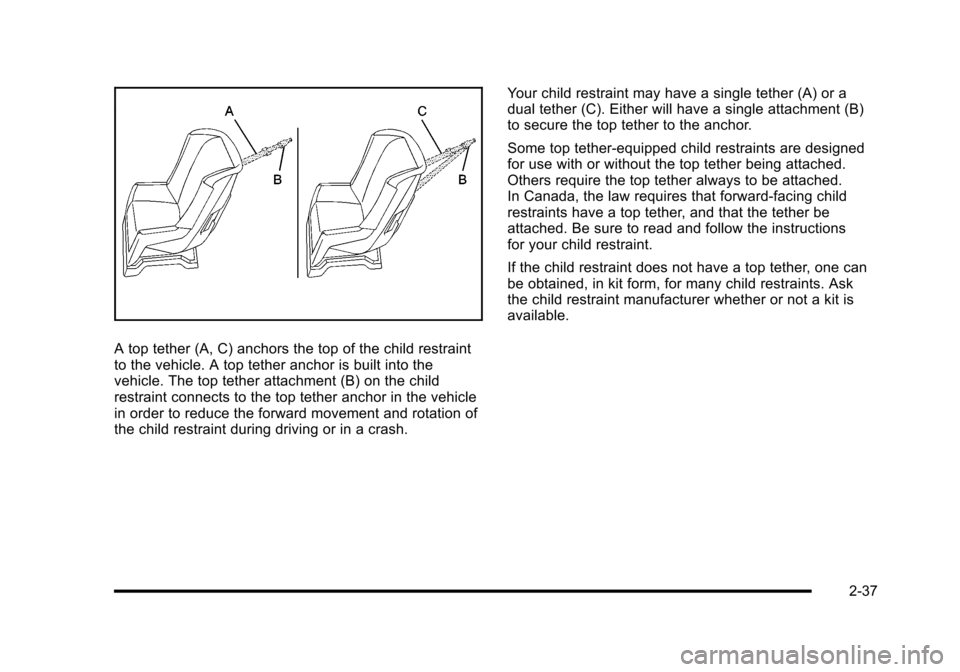
A top tether (A, C) anchors the top of the child restraint
to the vehicle. A top tether anchor is built into the
vehicle. The top tether attachment (B) on the child
restraint connects to the top tether anchor in the vehicle
in order to reduce the forward movement and rotation of
the child restraint during driving or in a crash. Your child restraint may have a single tether (A) or a
dual tether (C). Either will have a single attachment (B)
to secure the top tether to the anchor.
Some top tether-equipped child restraints are designed
for use with or without the top tether being attached.
Others require the top tether always to be attached.
In Canada, the law requires that forward-facing child
restraints have a top tether, and that the tether be
attached. Be sure to read and follow the instructions
for your child restraint.
If the child restraint does not have a top tether, one can
be obtained, in kit form, for many child restraints. Ask
the child restraint manufacturer whether or not a kit is
available.
2-37
Page 73 of 472
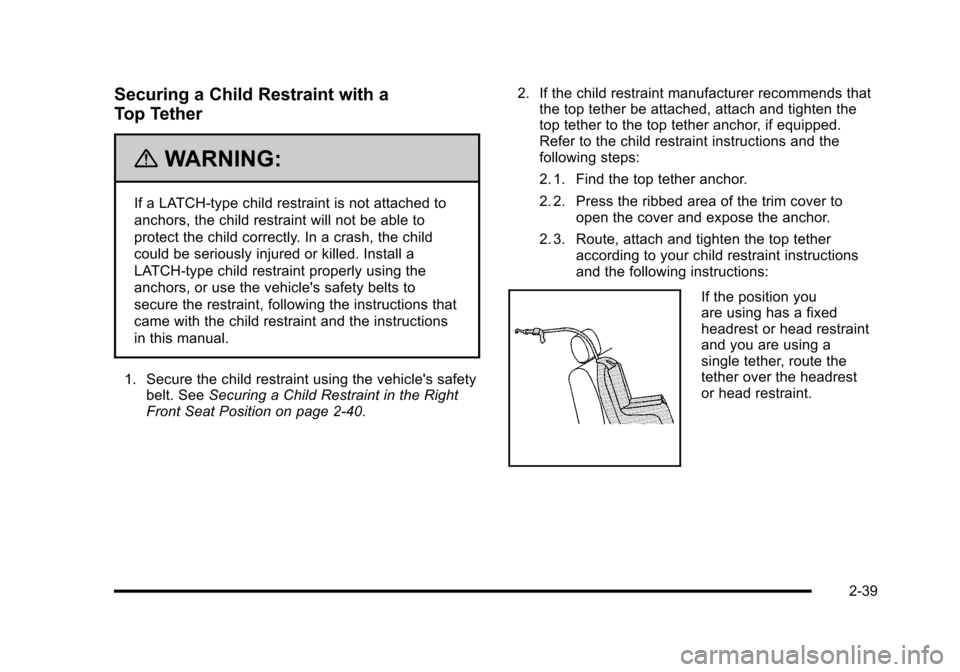
Securing a Child Restraint with a
Top Tether
{WARNING:
If a LATCH-type child restraint is not attached to
anchors, the child restraint will not be able to
protect the child correctly. In a crash, the child
could be seriously injured or killed. Install a
LATCH-type child restraint properly using the
anchors, or use the vehicle's safety belts to
secure the restraint, following the instructions that
came with the child restraint and the instructions
in this manual.
1. Secure the child restraint using the vehicle's safety belt. See Securing a Child Restraint in the Right
Front Seat Position on page 2‑40. 2. If the child restraint manufacturer recommends that
the top tether be attached, attach and tighten the
top tether to the top tether anchor, if equipped.
Refer to the child restraint instructions and the
following steps:
2. 1. Find the top tether anchor.
2. 2. Press the ribbed area of the trim cover to
open the cover and expose the anchor.
2. 3. Route, attach and tighten the top tether according to your child restraint instructions
and the following instructions:
If the position you
are using has a fixed
headrest or head restraint
and you are using a
single tether, route the
tether over the headrest
or head restraint.
2-39
Page 74 of 472
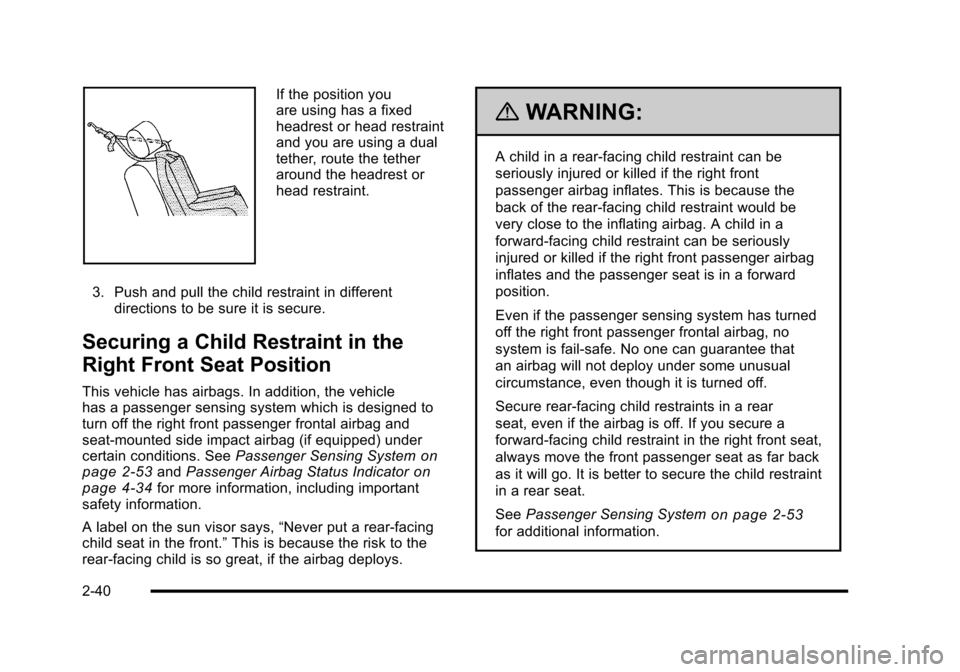
If the position you
are using has a fixed
headrest or head restraint
and you are using a dual
tether, route the tether
around the headrest or
head restraint.
3. Push and pull the child restraint in different directions to be sure it is secure.
Securing a Child Restraint in the
Right Front Seat Position
This vehicle has airbags. In addition, the vehicle
has a passenger sensing system which is designed to
turn off the right front passenger frontal airbag and
seat-mounted side impact airbag (if equipped) under
certain conditions. See Passenger Sensing System
on
page 2‑53and Passenger Airbag Status Indicatoron
page 4‑34for more information, including important
safety information.
A label on the sun visor says, “Never put a rear-facing
child seat in the front.” This is because the risk to the
rear-facing child is so great, if the airbag deploys.
{WARNING:
A child in a rear-facing child restraint can be
seriously injured or killed if the right front
passenger airbag inflates. This is because the
back of the rear-facing child restraint would be
very close to the inflating airbag. A child in a
forward-facing child restraint can be seriously
injured or killed if the right front passenger airbag
inflates and the passenger seat is in a forward
position.
Even if the passenger sensing system has turned
off the right front passenger frontal airbag, no
system is fail-safe. No one can guarantee that
an airbag will not deploy under some unusual
circumstance, even though it is turned off.
Secure rear-facing child restraints in a rear
seat, even if the airbag is off. If you secure a
forward-facing child restraint in the right front seat,
always move the front passenger seat as far back
as it will go. It is better to secure the child restraint
in a rear seat.
See Passenger Sensing System
on page 2‑53
for additional information.
2-40
Page 75 of 472
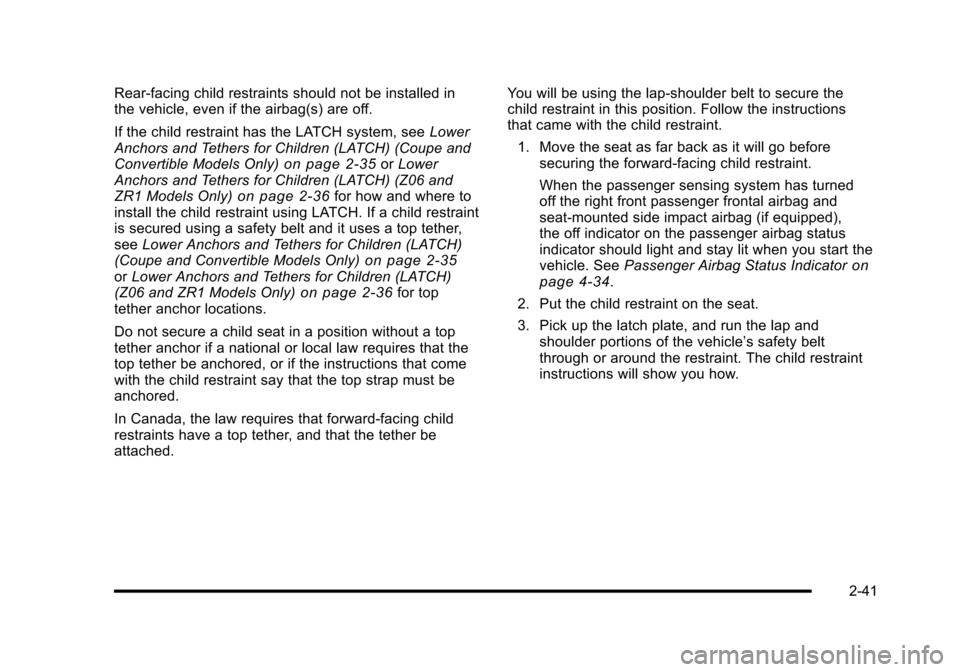
Rear-facing child restraints should not be installed in
the vehicle, even if the airbag(s) are off.
If the child restraint has the LATCH system, see Lower
Anchors and Tethers for Children (LATCH) (Coupe and
Convertible Models Only)
on page 2‑35or Lower
Anchors and Tethers for Children (LATCH) (Z06 and
ZR1 Models Only)
on page 2‑36for how and where to
install the child restraint using LATCH. If a child restraint
is secured using a safety belt and it uses a top tether,
see Lower Anchors and Tethers for Children (LATCH)
(Coupe and Convertible Models Only)
on page 2‑35or Lower Anchors and Tethers for Children (LATCH)
(Z06 and ZR1 Models Only)on page 2‑36for top
tether anchor locations.
Do not secure a child seat in a position without a top
tether anchor if a national or local law requires that the
top tether be anchored, or if the instructions that come
with the child restraint say that the top strap must be
anchored.
In Canada, the law requires that forward-facing child
restraints have a top tether, and that the tether be
attached. You will be using the lap-shoulder belt to secure the
child restraint in this position. Follow the instructions
that came with the child restraint.
1. Move the seat as far back as it will go before securing the forward-facing child restraint.
When the passenger sensing system has turned
off the right front passenger frontal airbag and
seat-mounted side impact airbag (if equipped),
the off indicator on the passenger airbag status
indicator should light and stay lit when you start the
vehicle. See Passenger Airbag Status Indicator
on
page 4‑34.
2. Put the child restraint on the seat.
3. Pick up the latch plate, and run the lap and shoulder portions of the vehicle’s safety belt
through or around the restraint. The child restraint
instructions will show you how.
2-41